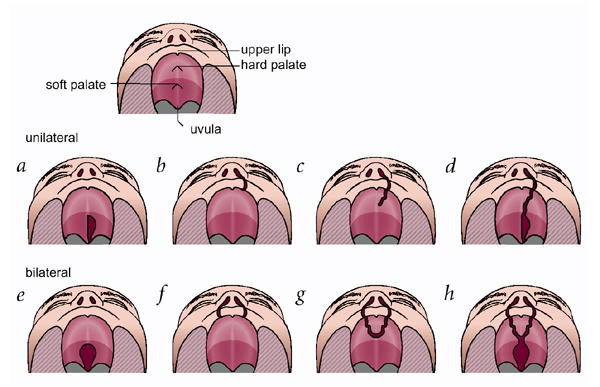
Speech Surgery and Cleft Lip/Palate?
-
Speech Surgery is used to treat resonance disorders in children. Resonance disorders occur when there is an opening, inconsistent movement or obstruction that changes the way air flows during speech through nasal and oral cavities. They can be caused by velopharyngeal insufficiency.
-
VPI affects resonance (quality of speech) and may cause the following:
-
hypernasality: too much nasal airflow
-
hyponasality: too little nasal airflow
-
cul-de-sac resonance: blocked sound in one of the cavities
-
mixed resonance
-
-
Most speech surgery exists in the context of pediatric cleft palate.
Source: Kummer, A. (2013). Cleft Palate & Craniofacial Anomalies: Effects on Speech and Resonance. Cengage Learning.
What is Cleft Lip and Palate?
-
Cleft lip and palate is the fourth most common birth defect and most common congenital defect of the face.
-
Failure of parts of the lip to come together results in cleft lip.
-
If a child has only a cleft lip, speech development should be typical or very close to typical.
-
-
Cleft palate occurs when the sections of the roof of the mouth do not fuse normally during fetal development, leaving an opening between the oral and nasal cavity.
-
Some clinical populations that may present with cleft palate:
-
Apert Syndrome
-
Crouzon Syndrome
-
Goldenhar Syndrome
-
Stickler Syndrome
-
Van der Woude Syndrome
-
Wolf-Hrischhorn Syndrome
-
Source: Kummer, A. (2013). Cleft Palate & Craniofacial Anomalies: Effects on Speech and Resonance. Cengage Learning.
Types of Cleft Palate

a.) unilateral cleft palate
b.) unilateral cleft lip
c.) unilateral cleft lip & (hard) palate
d.) unilateral cleft lip & (soft) palate
e.) bilateral cleft palate
f.) bilateral cleft lip
g.) bilateral cleft lip & (hard) palate
h.) bilateral cleft lip & (soft) palate
i.) submucous cleft palate
Souces: (http://www.nature.com/ng/journal/v32/n2/fig_tab/ng1002-219_F1.html); (https://elementsofmorphology.nih.gov/index.cgi?tid=30b9e9da9758d9d7)

i
Common Surgical Techniques
Furlow Palatoplasty
-
Furlow palatoplasty is plastic surgery technique used to lengthen tissue. It involves borrowing tissue from the width of the velum to add to the length. This is effective for mild VPI or a very narrow VP opening.
Pharyngeal Flap
-
This is the most commonly used procedure for VPI and is effective in management of midline gaps. The flap is raised from the posterior pharyngeal wall and sutured into the velum.
Pharyngeal Wall Augmentation
-
With this procedure, a filler is injected in the VP opening. Various materials include hydroxylapatite, cartilage, fascia, fat, silicone and proplast.
Source: Kummer, A. (2013). Cleft Palate & Craniofacial Anomalies: Effects on Speech and Resonance. Cengage Learning.
Educational Videos
Plastic surgeon John Meara, MD, from Boston Children’s Hospital briefly describes the different types of cleft and treatment procedures.
Where Can I Get More Information?
American Cleft Palate - Craniofacial Association: (http://www.acpa-cpf.org/)
American Speech-Language-Hearing Association (ASHA): (http://www.asha.org/public/speech/disorders/CleftLip/)
Cleft Palate Foundation: (http://www.cleftline.org/)
Recommended Reading
Abdel-Aziz, M., Nassar, A., Rashed, M., Naguib, N., & El-Tahan, A. R. (2015). Furlow palatoplasty for previously repaired cleft palate with velopharyngeal insufficiency. International Journal of Pediatric Otorhinolaryngology, 79(10), 1748-1751.
Goudy, S., Ingraham, C., & Canady, J. (2012). Noncleft velopharyngeal insufficiency: etiology and need for surgical treatment. International Journal of Otolaryngology. 2012